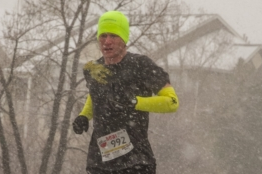This past summer, I wrote a blog post on making race adjustments based on various factors. Circumstances over the weekend gave me additional material in the same vein.
It was 5:45 a.m. this past Saturday. I was sitting in my study, drinking coffee, and looking out the window. In three and a half hours, I would be running the Snowman Stampede 10K in Littleton, CO. At the beginning of the week, the weather looked good for the race: mid-30s to low 40s, maybe a snow shower the night before, but with a 9:15 start and sunshine in the forecast, the paths would be fine by the time we toed the line.
Sunshine at the start was the only part of the early-week weather forecast that stayed constant. Otherwise, the Snowman Stampede lived up to its name. Six or seven inches of snow fell between Friday evening and Saturday morning and the temperature was in the low 20s. The course was mostly covered in a thin layer of snow (plows had been out) and one longer section at the end featured two wide tire tracks down a path with deeper snow in the middle between them.
Normally in a race I have a goal time in mind and, by looking around the starting line, I can make a fairly accurate guess on how the placing will play out. Well before the race started (starting in my study and concluding when I passed the nasty auto accident on I-25 during my drive down) I figured that I should go into the race with the mindset of it being a half race, half hard distance run. I did not pick a goal time and my mental tally of the competition was by reflex as my primary focus was to not wipe out and get injured. When the race was over, I had accomplished that goal. I would stand to run the next day.
Doing a cool-down run (cool-down being a debatable term) with some friends afterwards, we talked about how we had done. It wasn’t until that point that I realized the extent to which I had adjusted my race expectations. While I conscientiously didn’t worry as much about time, normally during a race I’ll keep track of how many people are in front of me and whether I can catch them. Not so that day. Though I had accurately guessed on the people who would finish ahead of me, I had been so focused on the path that the best answer I could come up with was that I was either 4th or 5th overall and ultimately, it turned out to be 5th.
My time was disappointing when I crossed the line but I had checked expectations further north on the highway. However, it turned out that the course was 6.6 miles, instead of 6.2. Some other runners and I think the turnaround sign may have gotten knocked down or covered in snow and the staff on the course used the next logical landmark which was a bridge. Knowing that, my time was much more palatable.
In some ways, it was pleasant to have a race where my focus was somewhere else. Though I and probably everyone else would gladly have preferred at least a dry course, there’s also a bonding among your fellow racers in circumstances like these, which can make the event more fun and yield good stories for years to come.
The race organizers sent everyone a solid discount for a future race due to the poor conditions. This was surprising as it was impressive that the staff and volunteers even showed up given how treacherous the roads were that morning.
My next scheduled race is in mid-April. For that one, it can be 50 degrees with sunshine or howling, blowing snow. Similar to the Snowman Stampede, I’ll be ready to toss aside any time goals and change other expectations if the weather is garbage.
Running food review of the week: (note–gels, bars, chews, and other items affect everyone differently. Try them on a short run before using them for a key training run or race): Gatorade Fierce Grape: I like this drink primarily as a recovery beverage. I’m not sure why, but it sits a little heavier with me if I use it before or during a run. However, as a recovery drink, it’s outstanding and it tastes like a slowly-starting-to-melt grape snow cone.

Running anecdotes, running food reviews, some race coverage, and more